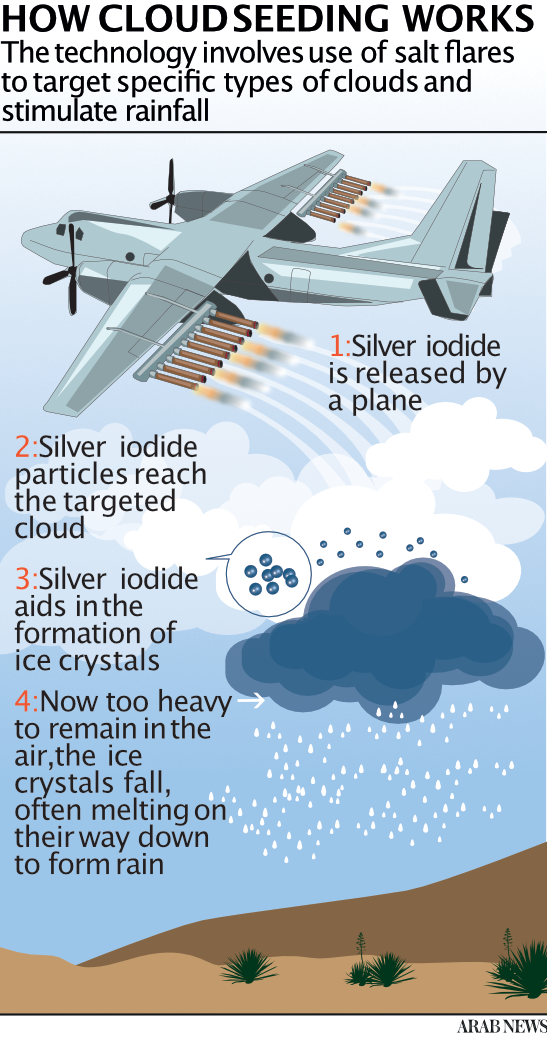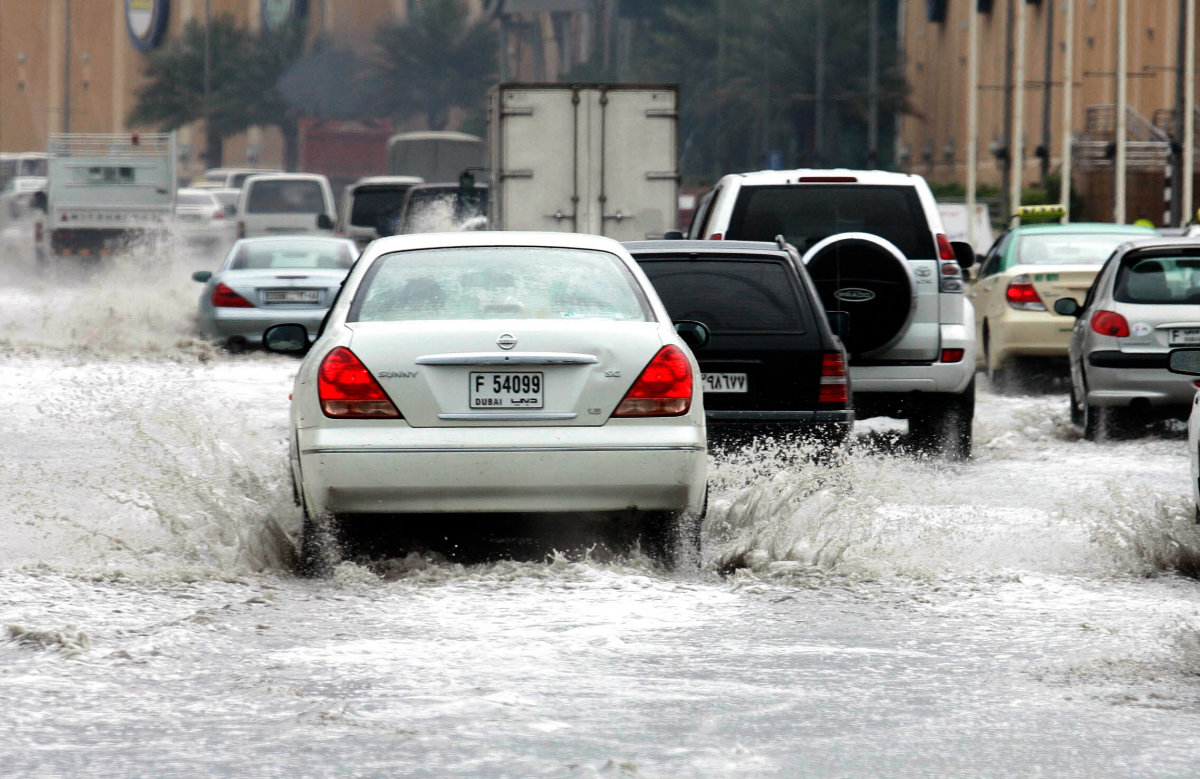DUBAI: Drone technology has more applications than most people imagine, including manipulating the weather. In the UAE, scientists are planning to deploy unmanned aerial vehicles to penetrate clouds and generate rainfall using electrical charges — a process that builds on the success of “cloud seeding.”
In common with other Gulf countries, heat and aridity are the bane of life in the UAE, where just 1.2 mm of rain fell in the first three months of 2021 and where summer temperatures often hit 50 C. Scientists are therefore exploring innovative solutions to the interrelated problems of extreme temperatures, heat waves, water scarcity and poor air quality.
The results of their efforts could bring benefits not only to the UAE but also to other Middle East and Central Asian countries with water-scarce environments.

“This is a very important and interesting initiative for the UAE, not only as a scientific or research experiment, but to make the country a global hub in cloud-seeding knowledge,” Dr. Mohamed Shamrukh, a civil engineer who participated in cloud-seeding feasibility studies in the Kingdom in 2007-2008, told Arab News. “Such an initiative is urgently needed in our region.”
As one of the driest countries on earth, the UAE has precious few freshwater resources of its own. As a result, its economy is highly reliant on imports and desalination — the process of removing salt from seawater — to irrigate crops and meet the demands of its growing population.
In fact, the UAE accounts for some 14 percent of the world’s desalinated water, second only to Saudi Arabia, which has also tapped cloud-seeding technology as a potential way of addressing its freshwater shortage.
Riyadh last year approved a cloud-seeding program aimed at increasing rainfall in the Kingdom by almost 20 percent. In the UAE, that work began earlier, in 2017, when the government invested $15 million in nine rain-enhancement projects.
Using experimental drone technology, scientists can create man-made downpours by delivering electric shocks to cumulus clouds, causing them to clump together and produce precipitation.

A pilot and a UAE official from the National Center for Meteorology and Seismology inspect a Beechcraft plane at the Al-Ain airport before another cloud-seeding sortie. (AFP/file photo)
The small, remote-controlled gliders, equipped with a payload of electric-charge emission instruments and customized sensors, fly at low altitudes to deliver an electric charge to air molecules.
Clouds naturally carry positive and negative charges, but by altering the balance of these charges, these electric shocks enable water droplets to merge into larger raindrops and fall from the sky.
Of course, once the rain has fallen, the next challenge is to prevent it from evaporating or simply flowing off into the sea. To this end the UAE has built around 130 dams and levees with a storage capacity of about 120 million cubic meters.
There are several methods of triggering rainfall that scientists are exploring, including the spraying of salt compounds, silver iodide and dry ice into the atmosphere.
If the drone technique proves successful in the long run, cloud seeding could play a major role in enhancing the wider region’s sustainable water supply for years to come. Rain-enhancement projects could help to mitigate drought conditions without the environmental, cost and efficacy concerns associated with methods involving salt flares.
“The UAE has similar weather and climate to the other Gulf countries and this leading experiment in the UAE is very useful to them,” Shamrukh said.
INNUMBERS
• 50 Countries looking to establish rain enhancement programs.
20% Targeted increase in KSA’s rainfall through cloud seeding.
18% KSA’s share of global production of desalinated seawater.
80-85% KSA’s water demand currently met by groundwater sources.
Earth’s surface is 71 percent water, but the Middle East and North Africa (MENA) region sees precious little of this life-giving resource. According to the UN, it is the world’s most water-scarce region, with 17 countries considered below the water poverty line.
Matters are made worse by rapid population growth, poor infrastructure and overexploitation of limited resources. Agriculture alone accounts for around 80 percent of water usage in the MENA region, according to the World Bank.
This overuse means the region’s natural groundwater reserves are not replenishing fast enough to keep pace with demand. Desalination of seawater and major dam projects have been the favored solutions, but these come with their own environmental downsides.
Shortages could have wide-reaching humanitarian consequences. Droughts destroy livelihoods, displace populations from rural to urban areas, and can result in conflict and unrest.

The cloud-seeing technology was first tried in the 1940s and was put into widespread use in the 1970s. (Shutterstock photo)
Around 1.1 billion people worldwide already lack reliable access to water, and 2.7 billion endure scarcity for at least one month of the year. By 2025, an estimated two-thirds of the world’s population may face water shortages.
Forecasts suggest water supplies will drop dramatically by 2030 and that rationing could become the new normal unless sustainable solutions are implemented.
Along with ground-based seeding generators, cloud seeding is perhaps one way to help top up dwindling reserves. Last year, the UAE conducted more than 200 cloud-seeding operations, led by its National Center of Meteorology and Seismology (NCMS).
A team of pilots and technicians at NCMS’s dedicated operations room analyzed data based on their observation of 150 cumulus clouds to identify those considered “seedable.”
These detached, cauliflower-shaped clouds are usually spotted in fair weather conditions, and often hug highland areas such as the UAE’s eastern Al-Hajar mountains, which deflect the warm air blowing in from the Gulf of Oman. They tend to develop as a result of convection and stay at base heights of 1,000 meters, with a width of up to one kilometer.

The UAE, which suffered from rare heavy rains in 2006, is normally arid for most of the year — and climate change is putting real pressure on where it and its neighbors will source water from in future. (AFP)
“Based on the previous experience the UAE has gained, they know and understand more of how to use their system of monitoring every drop of water that falls,” Dr Khalil Ammar, principal scientist in hydrogeology and water resources management at the International Center for Biosaline Agriculture in Dubai (ICBA), said. “They know which type of cloud they can use certain technologies on to avoid any risk of floods or damage on the ground.”
Cloud seeding is a rapidly growing science that the UAE is well placed to capitalize on. Being able to predict the distribution and intensity of rainfall in the Gulf and wider MENA region could prove critical in the years to come as climate change makes droughts more common.
“It’s very important to keep investigating and using leading technologies to enhance rainfall and increase opportunities for its occurrence,” Ammar said.
However, scientists must be cautious about the possible environmental side effects and other risks while generating rainfall artificially, including the potential for pollution and flash flooding.
“The UAE avoids certain types of clouds with huge quantities of water,” Ammar said. “We need to work more on showing evidence on what’s happening in this program and what implications and gains there are. Whatever drop of water you can bring in ultimately has high value because it adds to the water system of the country and region.”
For Shamrukh, there is still a long way to go, both in the development of seeding technology and in scientific understanding of the best processes. “Nowadays, there are many cloud-seeding techniques,” he said.
He and Ammar would both like to see more investment in rain-making technologies and much more regional cooperation to address the shared dangers posed by climate change and water shortages.
“Cloud seeding is a must, not a choice,” Ammar said. “Scientists should keep developing new ideas and innovations from all over the world and bring them here, if they are affordable and technically feasible to scale up.
“Maybe a joint program for the whole GCC is possible, as it will help improve their performance instead of working separately on monitoring.
“All this rain is valuable,” he said. “Countries can’t survive without this valuable resource.”
___________________
• Twitter: @CalineMalek


















